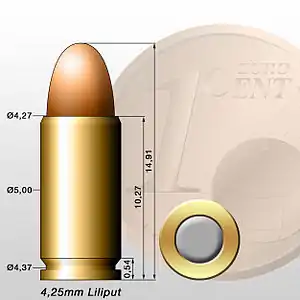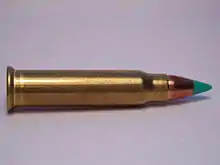4.25mm Liliput
The 4.25mm Liliput is a centerfire cartridge originally produced in Austria for self-loading pocket pistols made by Erika before World War I. In 1920 the Liliput pistol was designed by August Menz of Suhl to use the cartridge. The cartridge became best known by the Liliput name used on German ammunition after Austria ceased production. The cartridge headspaces on the mouth of the case. It was the smallest centerfire cartridge in production in the 1930s.[1]
| 4.25mm Liliput | ||||||||
|---|---|---|---|---|---|---|---|---|
 | ||||||||
| Type | Pistol | |||||||
| Place of origin | Austria-Hungary | |||||||
| Specifications | ||||||||
| Case type | Rimless, straight | |||||||
| Bullet diameter | 4.27 mm (0.168 in) | |||||||
| Neck diameter | 5.00 mm (0.197 in) | |||||||
| Base diameter | 5.00 mm (0.197 in) | |||||||
| Rim diameter | 5.00 mm (0.197 in) | |||||||
| Case length | 10.27 mm (0.404 in) | |||||||
| Overall length | 14.91 mm (0.587 in) | |||||||
| Ballistic performance | ||||||||
| ||||||||
| Source(s): "Textbook of Automatic Pistols" [1] | ||||||||
See also
References
-
- Wilson, R. K. Textbook of Automatic Pistols, pp.261-262. Plantersville, SC: Small Arms Technical Publishing Company, 1943.
This article is issued from Wikipedia. The text is licensed under Creative Commons - Attribution - Sharealike. Additional terms may apply for the media files.
